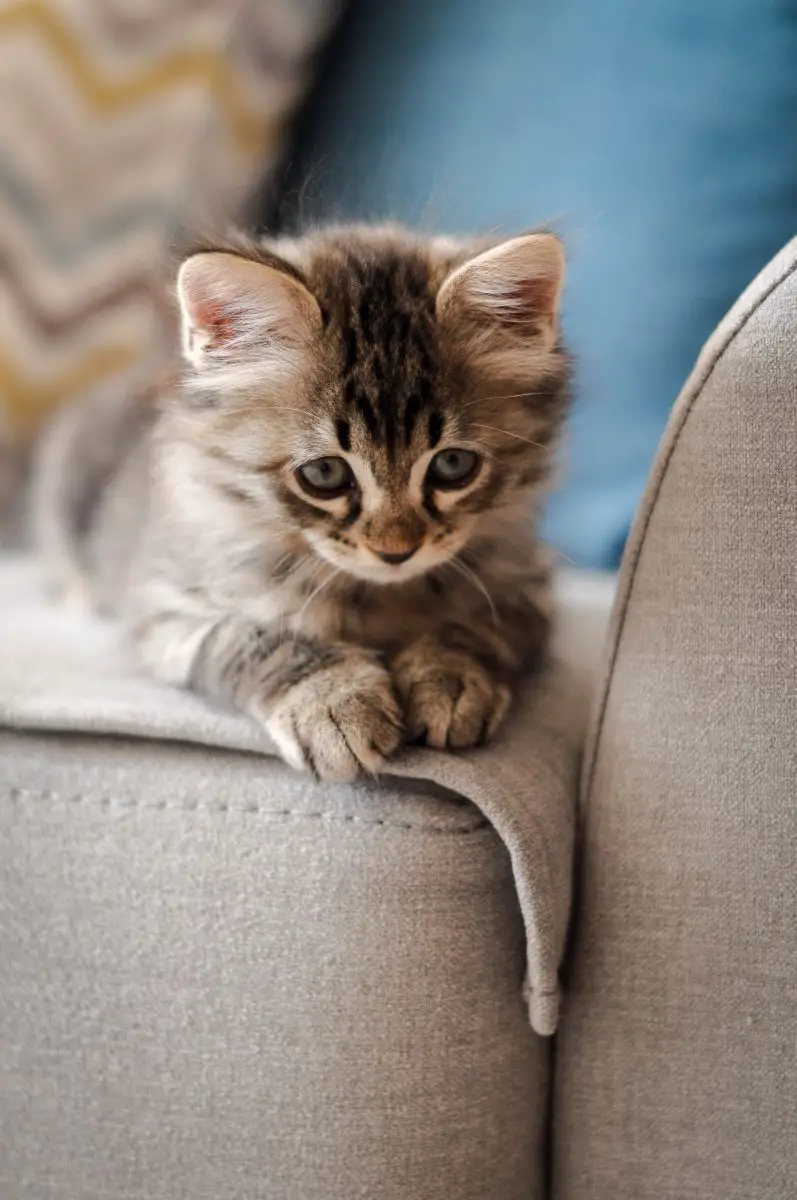If you own cats then you already know they’re some of the coolest animals on the planet. Ranked alongside dogs as the most popular domesticated furry friend, cats make excellent companions. But they’re also enigmatic little serial killers with a penchant for chewing on plants. No wonder some people believe that cats chose to be domesticated because they saw humans as useful in their quest to worldwide domination.
Is this true? Can’t say for certain, but we do have some fun and interesting facts about cats that are sure to jazz up your pet-themed trivia night.
Table of Contents
- Cute Facts About Cats
- Amazing Facts About Cats
- Fun Facts About Cats Behavior
- Interesting Facts About Cats For Kids to Impress Their Friends
- All The Cat Facts You’ll Ever Need
Cute Facts About Cats
There’s no denying that cats are adorable. While they might not be as goofy and endearing as dogs, cats have features and moods that make people go crazy. Who doesn’t want to touch the toe beans?
Here are some cute facts about cats that you should definitely know:
- Most cats have no eyelashes. Yes, they have fur around their eyelids that resembles eyelashes, but they have no need for eyelashes. There is something else that does the job of eyelashes for cats—the third eyelid, also known as nictitating membrane.
- Cats can’t see directly under their nose. That is why you can’t put a treat down in front of them and expect them to find it right away. You can, however, point to what you want them to see, and your cat is sure to follow the gesture.
- A group of cats is know as a clowder.
- There is a Hebrew legend that says God created cats when Noah needed help protecting his stores of food from rats on the Ark. A lion sneezed, and out came a pair of cats!
- Cats can recognize different voices. So yes, they are ignoring you when you call their name.
- Cats also have selective hearing, choosing only what they know to be beneficial. Dogs do not have selective hearing, in case you were wondering.
- Every cat has a unique “print” on their nose that is much like human fingerprints. How cute.
- Contrary to popular belief, cats don’t really need milk. Fascinatingly, most adult cats are lactose intolerant and can’t handle it. This is because, shortly after being weaned, cats stop producing lactase, the enzyme needed to break down lactose.

Amazing Facts About Cats
Now that you’ve gotten your feet wet with cute cat facts, it’s time to delve into the facts that are truly amazing.
Cats Can’t Climb With Their Heads Down
Have you ever noticed that cats are fine scaling impossibly tall trees without a moment’s hesitation? Yet when they go to return to the ground, they freak out? The reason why so many fire departments are deployed to rescue cats stuck in trees is because cats can’t climb with their head pointed down.
One of the reasons for this is their claws. When climbing, their claws hook into the tree or telephone pole and help propel them up. Going down doesn’t provide the same benefit. So do cats really get stuck in trees despite being masterful climbers? Yep.
Cats Can Run Up to 30 Miles Per Hour
Sure, cats might seem lazy when they roll on their backs and lounge in the sun all day, but they’re not. When it comes to speed, domesticated cats are fast. In short spurts, some cats can reach speeds of 30 mph (48 kmh). To compare, the max speed of a cheetah is 74.56 mph (119 kmh) and lions max out around 50 mph (81 kmh). When you consider the size difference, that 30 mph is impressive.
How do small house cats achieve such speed? When running, the front and back legs work in unison. The front legs push while the back legs launch their body, giving them the ability to race around the house at 3 in the morning.
Tortie and Calico Cats Are Almost Always Female
If you have a calico or tortoiseshell male cat, they’re extremely rare. Only 1 in 3,000 calico cats are male. How does this happen? It’s the X and Y chromosome.
Similar to humans, female cats have an XX pairing, while males have XY. Since female cats can only pass the X chromosome, which corresponds to fur color, many female cats end up expressing the color of both the mother and father, as well as white fur. Male cats only get the fur color from their mother.
Similarly, most ginger cats are male!
Do Cats Dream of Catnip Sheep?
Cats and humans have quite a bit in common, including REM sleep. During the Rapid Eye Movement stage, dreaming occurs. Cats might not dream about fighting dragons or showing up to high school naked, but they do relieve their day-to-day schedule. You might notice that your cat is moving its paws or twitching. Some even sleepwalk, though that’s rare. Most often, a cat’s dream consists of reliving a good meal or playing with toys.
Navigating By the Rays of Sun
Ever wonder how a lost cat can find its way back to your front door without issue? For many, many years, this was a mystery. Scientists discovered that cats have great memory for where they live and travel. They have mind maps of the routes they take, as well as cues that help them find their way if they’re unsure where they are headed. Cats also look to the position of the sun in the sky and use that for directions.
Smart!
Cats Have More Bones Than Humans
Humans might tower over cats, but that doesn’t mean our skeletons are as complex. Cats have 250 bones while humans only have 206. Most of the extra bones are found in the tail, giving a cat extra mobility. In fact, the tail alone has between 19-23 vertebrae, which contributes to 10% of all the bones in a cat’s body.
Cats Sweat Through Their Feet
Some of the first cats to walk the planet were from desert regions. Being that they were walking across arid regions in search of food, they evolved to cope with warm temperatures. Many breeds aren’t as adept in dealing with the heat as their ancestors, but one unique evolutionary trait remains: sweating through the paws.
When a cat is overheated, they will pant and sweat out between their toe beans. You may even notice a trail of sweaty paw prints on the kitchen floor. However, most cats have such small feet that sweating out the paws isn’t always helpful, so they may also excessively lick themselves to cool down.

Fun Facts About Cats Behavior
Having learned some facts that show just how incredible a cat is, it’s time to focus on their behaviors. Cats are, in many ways, the exact opposite of dogs. They are aloof, independent, and inquisitive to the point of persistence. But there are many cats that also display dog-like qualities, such as going on walks or hikes with their human companions, fetching toys, and protecting their humans from danger.
Here are more fun facts about cats behavior that you might not know:
Cats Sleep Up to 18 Hours a Day
Cats are some of the most prolific sleepers in the world. A newborn kitten will sleep nearly 24 hours. As cats get older, they need less sleep, but most average out around 18 hours a day. To put it this way, if you own a 9 year old cat, they have only been awake for 3 years of their life.
Running around and hunting prey expends a lot of energy in the wild. Sleep helps them conserve energy for the hunt. The same can’t be said for house cats, which is why some of them have weight issues!
Meowing Is Reserved For Humans Only
Here is a fun fact about cat behavior: meowing doesn’t happen between cats. When a cat meows, they are calling for humans.
It’s believed that when cats are kittens, they use meowing to communicate with their mothers. As they get older, they might start seeing their humans as their moms while reserving other forms of vocalizations for their feline friends.
Adult cats talk to one another with their tails, faces, and scent. People, on the other hand, get a full range of vocalizations that indicate all kinds of things, from greetings to “Get off your butt, I’m hungry!”
Toilet Manners
Cats are very clean creatures and like to keep themselves looking prim. This holds true for the litter box. Often, cats will cover their business with clean litter. It is believed that doing this mirrors behaviors from living in the wild, when covering their urine and poo hides their scent from predators. So what does it mean when your cat leaves their piles uncovered?
When your cat doesn’t cover his poop, it’s a sign that they don’t fear you.
Kitty Communication
Meowing isn’t the only way a cat talks to you. For instance, when a cat rubs on you with their face, it means that they are marking you as their territory. There are scent glands around the nose and cheeks that leave their scent behind.
Furthermore, there are tail shapes and wags, slow blinks, kneading or “making biscuits.” That butt in your face that you hate so much? It’s a sign of friendship. Another signal that your cat thinks of you as a friend is when they drape their tail over you.
Here are some more behavior-related facts about cats:
- When cats are bored, they will attack your ankles. If their cats aren’t out, it’s not a sign of aggression but of playfulness.
- Does your cats tail vibrate when they see? It’s weird to see, but it means that they’re happy to see you.
- Cats thieve objects from their owners and others because it reminds them of hunting.
- The next time you watch two cats fighting or playing, take note of the one who hisses. A hissing cat isn’t showing aggression but fear, and it means that they feel extremely vulnerable.
- Avoid making direct eye contact with your cats, as they find such behavior intimidating. This is different from dogs who are friendly with you; dogs use eye contact to communicate.

Interesting Facts About Cats For Kids to Impress Their Friends
Regardless of their age, kids will love these facts about their furry friends. Pass around these facts at the dinner table or on the way to school:
- Sir Isaac Newton, the same scientist who discovered gravity, invented the first cat door.
- A cat’s sense of hearing is 5 times greater than a human’s.
- Cats can also rotate their ears a full 180-degrees.
- Cats can jump five times higher than their height.
- A normal cat’s purr is between 25-150 Hz, which is at the frequency bones and muscles beginning repairing themselves. It’s believed that purring is a form of self-healing and self-soothing.
- The record holder for the loudest purr is a cat named Merlin from Torquay, UK. His purrs reach 67.8 decibels, which is more than double the normal purr of 25 db.
- House cats share about 95% of their genetics and behaviors with tigers. So yes, you do have a little tiger in your home.
- Developmentally, the first year of a cat’s life is equal to the first 15 years of a person’s life. At 2 years old, a cat’s development is equal to a 25 year old human. From then on, a cat’s years equal about 7 of a person’s.
All The Cat Facts You’ll Ever Need
What are some mind blowing facts about cats? Go through the list again, if needed, because there are so many interesting facts about cats here. Now that you know a little bit more about cats, you may have a newfound love and appreciation for your purring companion. The next time they meow, remember it’s just for you!
Learn more about your feline pal in out post about cat tail meanings!




